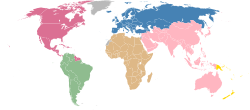Members of FIFA affiliated-confederations

This section lists the current:
- 211 women's national football teams affiliated to FIFA, through their national football associations.
- 11 women's national football teams who have membership in one of FIFA's affiliated continental confederations, but are not members of FIFA. [1]
FIFA members are eligible to enter the FIFA Women's World Cup and matches between them are recognized as official international matches. Based on their match results over the previous four-year period, the FIFA Women's World Rankings, published monthly by FIFA, compare the relative strengths of the national teams.
Some national teams that are members of a confederation but not FIFA members compete in confederation-level and subregional tournaments. These teams, however, are not allowed to participate in the World Cup.
The six confederations are:
- Asia – Asian Football Confederation (AFC) [note 1]
- Africa – Confederation of African Football (CAF) [note 1]
- North and Central America and the Caribbean – Confederation of North, Central America and Caribbean Association Football (CONCACAF)
- South America – South American Football Confederation (CONMEBOL)
- Oceania – Oceania Football Confederation (OFC)
- Europe – Union of European Football Associations (UEFA)
FIFA runs the Women's World Cup as a tournament for national teams to find the world champion. Each confederation also runs its own championship to find the best team from among its members:
- AFC – AFC Women's Asian Cup
- CAF – Women's Africa Cup of Nations
- CONCACAF – CONCACAF W Championship
- CONMEBOL – Copa América Femenina
- OFC – OFC Women's Nations Cup
- UEFA – UEFA European Women's Championship
AFC (Asia)
Due to the geographical size of Asia, the AFC is subdivided into five sub-federations:
- West Asian Football Federation (WAFF) – represents countries at the western extremity of the continent, except Israel.
- East Asian Football Federation (EAFF) – represents nations in East Asia, plus Guam and the Northern Mariana Islands.
- Central Asian Football Association (CAFA) – represents countries in Central Asia, comprising Afghanistan, Iran, Russia and most of Soviet Central Asia, except Kazakhstan.
- South Asian Football Federation (SAFF) – represents countries in South Asia.
- ASEAN Football Federation (AFF) – represents countries in Southeast Asia, plus Australia.
|
- National governing body was formerly a member of OFC (1966–2006)
- National governing body is a member of UAFA
- Official name used by FIFA and AFC for People's Republic of China
- Official name used by FIFA and AFC for Republic of China (Taiwan); national governing body was a member of OFC from 1975 to 1989
- Official name used by FIFA and AFC for Islamic Republic of Iran
- Official name used by FIFA for Democratic People's Republic of Korea; official name used by AFC is DPR Korea
- Official name used by FIFA and AFC for Republic of Korea
- Official name used by FIFA and AFC for Kyrgyzstan
- National governing body is a full member of AFC but not a FIFA member
- National governing body was formerly a member of OFC (2005–2009)
- Official name used by FIFA and AFC for national team representing the Palestinian Territories
CAF (Africa)
Due to the geographical size of Africa, CAF is divided into five regional federations:
- Council for East and Central Africa Football Associations (CECAFA) – represents nations generally regarded as forming the regions of East Africa and some nations of Central Africa.
- Council of Southern Africa Football Associations (COSAFA) – represents nations generally regarded as forming Southern Africa, as well as island states off the coast of Southern Africa.
- West African Football Union/Union du Football de l'Ouest Afrique (WAFU/UFOA) – represents nations in West Africa.
- Union of North African Federations (UNAF) – represents nations regarded as forming North Africa.
- Union des Fédérations du Football de l'Afrique Centrale (UNIFFAC) – represents some of the nations that form Central Africa.
|
- National governing body is a member of UAFA
- Official name used by FIFA for Democratic Republic of the Congo; official name used by CAF is DR Congo
- National governing body is an associate member of CAF but not a FIFA member
- National governing body was a full member of CAF briefly during 2017
- National governing body is a member of ConIFA. Was previously a member of the N.F.-Board.
CONCACAF (North, Central America, and the Caribbean)
The CONCACAF federation is divided into three regional federations that have responsibility for part of the region's geographical area:
- Caribbean Football Union (CFU) – represents all 27 nations in the Caribbean, plus Bermuda and three nations in South America. [note 2]
- North American Football Union (NAFU) – represents the three countries in North America (not including Central America).
- Union Centroamericana de Fútbol (UNCAF) – represents the seven countries in Central America.
|
- National governing body is a full member of CONCACAF but not a FIFA member
CONMEBOL (South America)
OFC (Oceania)
|
- Official name used by FIFA for New Zealand; official name used by OFC is New Zealand
- National governing body was formerly a member of AFC (1964–1966)
- National governing body is an associate member of the OFC but not a FIFA member
- National governing body is a member of ConIFA
UEFA (Europe)
|
- National governing body was formerly a member of AFC (1954–1974); joined UEFA in 1994
- National governing body was formerly a member of AFC (1993–2002)
- Team currently suspended from participation in FIFA and UEFA competitions in response to Russia's 2022 invasion of Ukraine [2]
